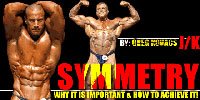Peanut Butter Banana Bulking Protein Shake
A good protein shake for bulking. Ingredients include your favorite protein powder, banana and peanut butter.
What You Need
8 oz skim milk
1 banana
1 tbsp peanut butter
2 scoops of whey protein powder
Cooking Instructions
Place ingredients into a blender and blend until smooth. You can also use whole milk and additional peanut butter, and turn this protein shake into a higher calorie weight gainer. Nutritional information for this reciped based on 2 scoops of whey protein blend and a medium banana. By using whole milk instead of skim milk, and by adding an additional tbsp of penut butter, this shake would provide over 600 calories. Recipe provided by Jmango.
Serving Suggestions
Makes one protein drink.

Nutritional Info
498 calories
58 grams of protein
44.3 grams of carbs
11.2 grams of fat







 Think about the upper arm-bone. The pec attaches perhaps 1.5 inches away from the base of the bone, near the shoulder-joint. When you're pressing weights, you have biomechanics working against you (it's like holding a short bar with one hand at the very end!
Think about the upper arm-bone. The pec attaches perhaps 1.5 inches away from the base of the bone, near the shoulder-joint. When you're pressing weights, you have biomechanics working against you (it's like holding a short bar with one hand at the very end!

